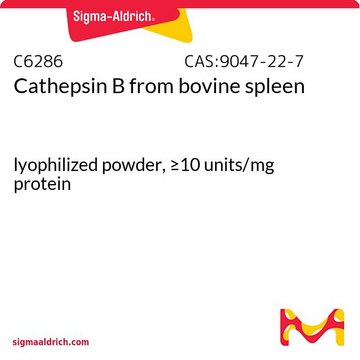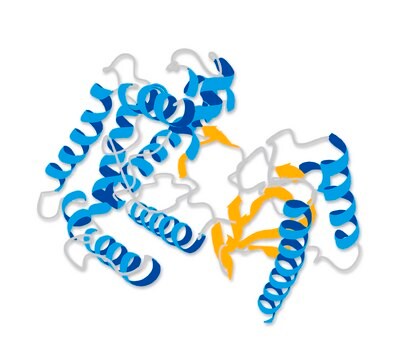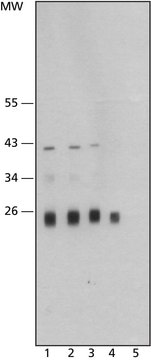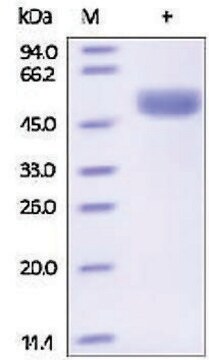C6854
Cathepsin L from human liver
≥0.5 units/mg protein, solution
Se connecterpour consulter vos tarifs contractuels et ceux de votre entreprise/organisme
About This Item
Numéro CAS:
Numéro MDL:
Code UNSPSC :
12352200
Nomenclature NACRES :
NA.32
Produits recommandés
Source biologique
human liver
Niveau de qualité
Forme
solution
Activité spécifique
≥0.5 units/mg protein
Technique(s)
activity assay: suitable
Plage de pH
4.5—5.5
Numéro d'accès UniProt
Application(s)
pharmaceutical
Conditions d'expédition
dry ice
Température de stockage
−20°C
Informations sur le gène
human ... CTSL1(1514)
Description générale
The cathepsin L (CTSL) gene is mapped to human chromosome 9q21.33. It encodes a lysosomal cysteine proteinase that belongs to the peptidase C1 family. The enzyme is a dimer of a heavy (175 amino acids) and a light chain (42 amino acids) linked by disulfide bonds.
Application
Cathepsin L (CTSL) from human liver has been used:
- to digest mutant transforming growth factor β-induced (TGFBIp) and LC3 (autophagosomes marker) proteins in vitro
- to digest the pH-dependent fibril of a pre-melanosomal protein (Pmel17) repeat domain (RPT) isoform and study the effect of pH on sRPT aggregation kinetics by tryptophan fluorescence
- to analyze the inhibition of CTSL by small molecules or drugs in a cell-free system
Actions biochimiques/physiologiques
Cathepsin L (CTSL) exhibits endopeptidase activity and breaks peptide bonds with aromatic residues. This enzyme is functional at pH 3.0–6.5 with thiol compounds. Elastin, collagen, and α-1 protease inhibitors act as substrates for cathepsin L (CTSL). CTSL cleaves several proteins including enzymes, receptors, and transcription factors. It is involved in antigenic peptide production and controls B-cells homeostasis. It is associated with myofibril necrosis and tumor progression. Increased expression of CTSL promotes metastasis and relates to poor prognosis in cancer patients. Increased expression of CTSL is observed in breast cancer. CTSL is implicated in glioblastoma multiforme (GBM), middle east respiratory syndrome (MERS), gingival overgrowth, and severe acute respiratory syndrome coronavirus 2 (SARS-CoV-2). It has a higher specific activity than cathepsin B and H in the degradation of a variety of physiological protein substrates.
Définition de l'unité
One unit will hydrolyze 1.0 μmole of Z-Phe-Arg-AFC per minute at pH 5.5 at 25 °C.
Forme physique
Solution in in 20 mM malonate, pH 5.5, 1 mM EDTA, and 400 mM NaCl.
Produit(s) apparenté(s)
Code de la classe de stockage
10 - Combustible liquids
Classe de danger pour l'eau (WGK)
WGK 3
Point d'éclair (°F)
Not applicable
Point d'éclair (°C)
Not applicable
Faites votre choix parmi les versions les plus récentes :
Déjà en possession de ce produit ?
Retrouvez la documentation relative aux produits que vous avez récemment achetés dans la Bibliothèque de documents.
Les clients ont également consulté
Bing-Jie Lv et al.
Atherosclerosis, 230(1), 100-105 (2013-08-21)
Cathepsin L (CatL), cathepsin K (CatK), and cathepsin V (CatV) are potent elastases implicated in human arterial wall remodeling. Whether plasma levels of these cathepsins are altered in patients with abdominal aortic aneurysms (AAAs) remains unknown. Plasma samples were collected
Stefan Tholen et al.
Cellular and molecular life sciences : CMLS, 71(5), 899-916 (2013-07-03)
Endolysosomal cysteine cathepsins functionally cooperate. Cathepsin B (Ctsb) and L (Ctsl) double-knockout mice die 4 weeks after birth accompanied by (autophago-) lysosomal accumulations within neurons. Such accumulations are also observed in mouse embryonic fibroblasts (MEFs) deficient for Ctsb and Ctsl.
Violeta Morin et al.
PloS one, 7(11), e46850-e46850 (2012-11-13)
Proteolysis of sperm histones in the sea urchin male pronucleus is the consequence of the activation at fertilization of a maternal cysteine protease. We previously showed that this protein is required for male chromatin remodelling and for cell-cycle progression in
M Hafner Česen et al.
Cell death & disease, 4, e818-e818 (2013-10-05)
A sigma-2 receptor agonist siramesine has been shown to trigger cell death of cancer cells and to exhibit a potent anticancer activity in vivo. However, its mechanism of action is still poorly understood. We show that siramesine can induce rapid
Bailey Miller et al.
Journal of natural products, 77(1), 92-99 (2013-12-25)
A number of marine natural products are potent inhibitors of proteases, an important drug target class in human diseases. Hence, marine cyanobacterial extracts were assessed for inhibitory activity to human cathepsin L. Herein, we have shown that gallinamide A potently
Notre équipe de scientifiques dispose d'une expérience dans tous les secteurs de la recherche, notamment en sciences de la vie, science des matériaux, synthèse chimique, chromatographie, analyse et dans de nombreux autres domaines..
Contacter notre Service technique












